As an Amazon Associate KitchenwareSets.com earns from qualifying purchases.
Small Studio Apartment Kitchen Designs That Actually Work
Struggling to prep a meal on that tiny sliver of counter space you call a kitchen? You’re not alone.
A studio apartment kitchen is part of your main living area, meaning its clutter is always on display. This lack of separation often leads to constant frustration over insufficient storage and zero workspace. It feels like an impossible puzzle.
The solution for a small studio apartment kitchen is to blend multi-functional items, smart vertical storage, and clever organization hacks. This guide will show you proven designs that create a space that is both highly functional and stylish. Discover how to reclaim your kitchen and make it work for you.
Why Do Most Studio Kitchens Feel So Cluttered and Impossible?
Living in a studio apartment means every square inch counts, and nowhere is that pressure felt more than in the kitchen. The core problem is the constant battle between functionality and extremely limited square footage. You need space for appliances, storage for food and cookware, and a clear surface for meal prep, but you have to fit it all into a small, open-plan corner.
This leads to the classic symptoms of a struggling studio kitchen: countertops buried under appliances and drying dishes, drawers that are a jumbled mess of utensils, and cabinets overflowing with pots and pans. It’s not just messy; it’s stressful. It makes cooking feel like a chore rather than a joy.
But it doesn’t have to be this way. The key is to stop thinking about what you can’t fit and start thinking about how to use the space you do have more intelligently. The following are not just pictures of pretty kitchens; they are proven, actionable small studio apartment kitchen ideas that solve these exact problems. We’ll focus on multi-functional items, utilizing vertical space, and implementing clever storage solutions to keep your countertops clear and your kitchen organized for good.
9 Smart Studio Kitchen Designs That Maximize Every Inch
Here are nine tested and proven solutions designed to tackle the most common complaints about tiny apartment kitchens. Each idea is a mini-project you can do, turning your cramped corner into a clever, functional, and stylish space.
1. Go Vertical to Reclaim Your Countertops
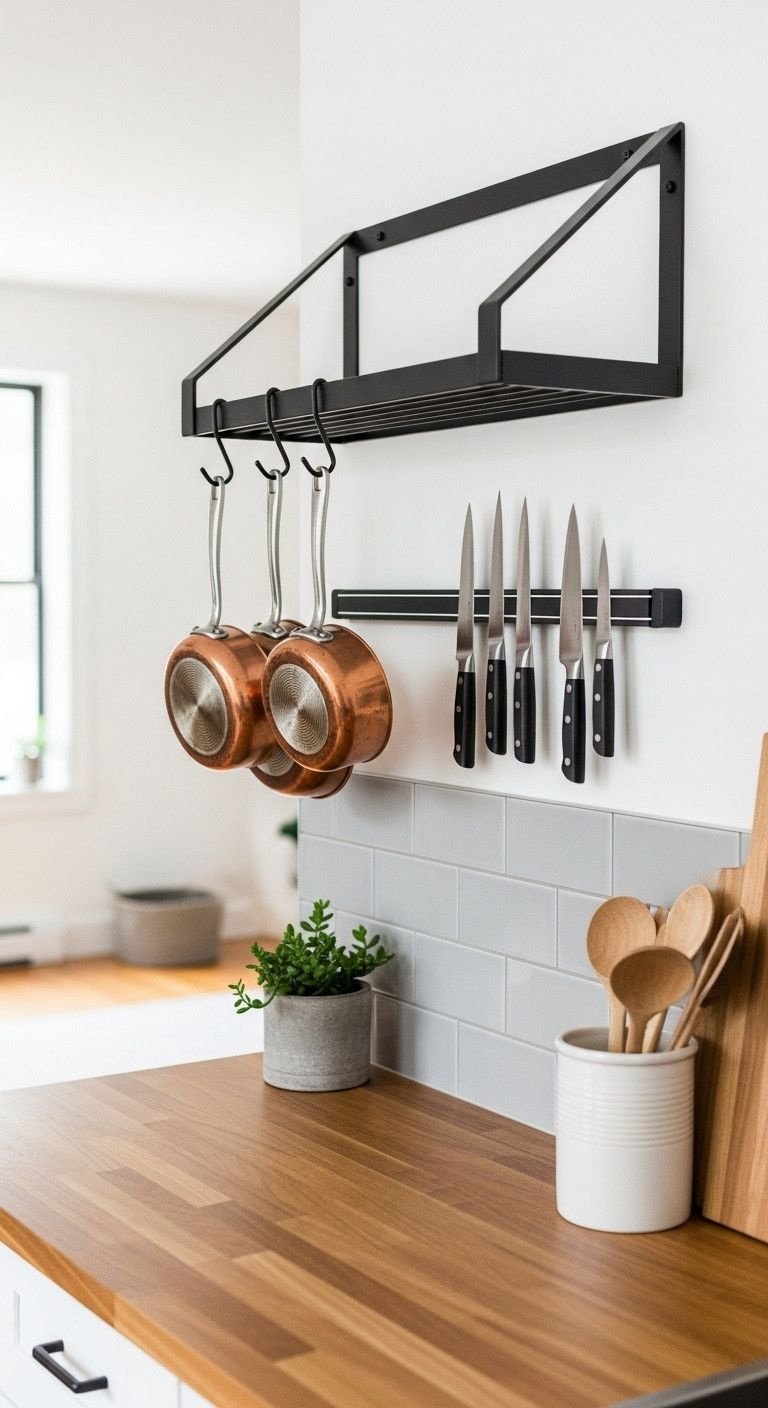
Pin this genius space-saver to your ‘Kitchen Goals’ board!
Your countertops are prime real estate, but they often become a default storage zone for bulky items like knife blocks and cookware. The most effective way to organize a small kitchen is to utilize the empty vertical space on your walls. A wall-mounted pot rack and a magnetic knife strip are two of the best vertical storage solutions to instantly free up counter and cabinet space.
Materials Needed:
- Heavy-duty wall-mounted pot rack with S-hooks
- Strong magnetic knife strip (at least 16 inches long)
- Stud finder
- Power drill and appropriate drill bits
- Level
- Pencil for marking
Step-by-Step Directions:
- Identify the Best Wall: Choose a clear wall space, preferably above your main prep area, that is free of cabinets.
- Locate the Studs: Use a stud finder to locate the wooden studs behind the drywall. Mark their locations with a pencil. It’s crucial to anchor heavy items like pot racks into studs.
- Position and Mark: Hold the pot rack against the wall, use a level to ensure it’s straight, and mark the screw holes over the stud locations. Repeat for the magnetic knife strip.
- Drill Pilot Holes: Drill pilot holes on your marks. This makes it easier to drive the screws in.
- Mount Securely: Screw the pot rack and knife strip firmly into the wall. Give them a gentle tug to ensure they are secure.
- Organize Your Items: Hang your most-used pots and pans on the S-hooks and arrange your knives on the magnetic strip.
Pro-Tip: Before you buy a pot rack, measure the height of your tallest pot to ensure you have enough vertical clearance above your countertop.
2. Add a Flexible Workspace with a Rolling Kitchen Cart
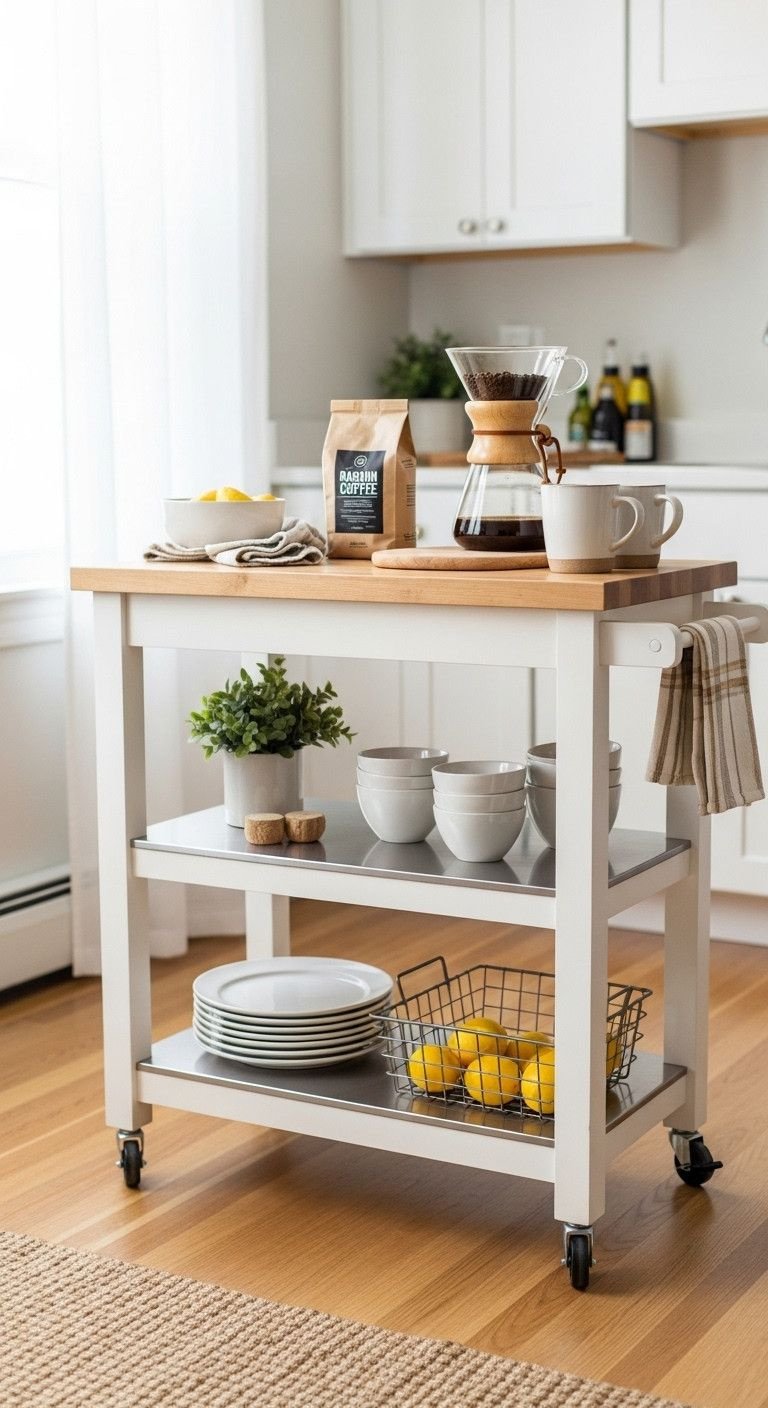
Save this multi-functional island idea!
When you have no counter space, a rolling kitchen island cart is a game-changer. This piece of multi purpose furniture provides the extra prep surface you desperately need, plus it offers additional open storage on its lower shelves. Because it’s mobile, it offers incredible flexibility; use it as a mini island when you’re cooking, then push it against a wall to serve as a coffee bar or extra storage when you’re done.
Materials Needed:
- A rolling kitchen cart that fits your space (measure first!)
- Look for features like a solid wood top, shelves, drawers, and locking wheels.
- Baskets or bins for organizing items on the shelves.
Step-by-Step Directions:
- Measure Your Space: Before buying, measure the floor area where you plan to use the cart. Ensure you have enough room to walk around it comfortably.
- Assemble the Cart: Follow the manufacturer’s instructions to assemble your kitchen cart. Make sure to properly install the locking casters.
- Create Zones: Dedicate the cart to a specific purpose. It could be your coffee station, a baking prep area, or a mini bar.
- Organize the Shelves: Use the lower shelves for storing items like small appliances (mixer, blender), cookbooks, or bowls. Use baskets to contain smaller, loose items.
- Position and Lock: Roll the cart into position when you need it for meal prep. Lock the wheels to keep it stable and safe while you’re working. When you’re done, you can push it against a wall to free up floor space.
Lesson Learned: A cart with a built-in towel bar and hooks on the side is a game-changer for hanging dish towels and utensils, freeing up even more space.
3. Reclaim Sink Space with an Over-the-Sink Rack
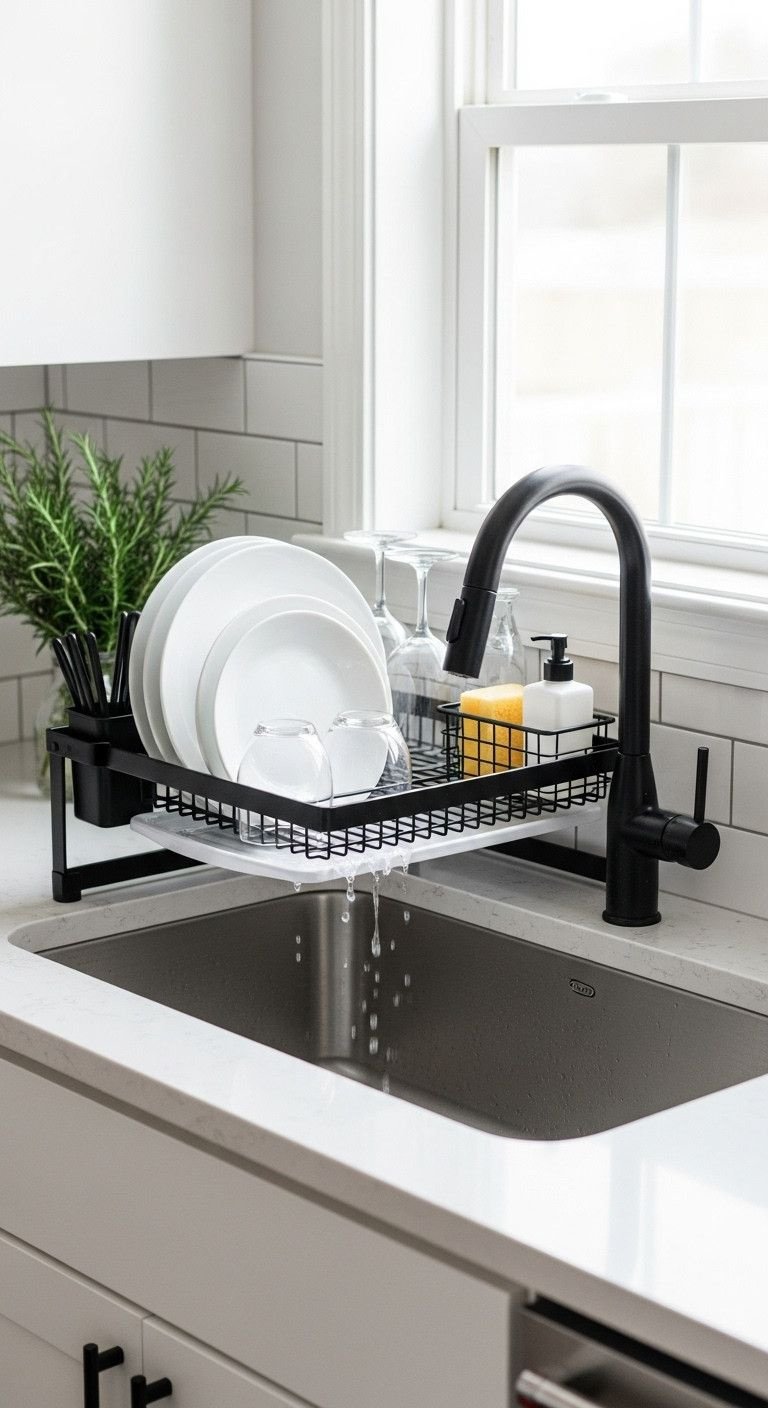
Need more counter space? Pin this clever hack!
A traditional dish rack is a major space hog. An over the sink drying rack is one of the smartest small kitchen organization hacks because it utilizes the unutilized vertical space above your sink. This clever device allows you to wash dishes and place them directly above to drip-dry into the sink, completely bypassing the need for a countertop rack and keeping your limited surfaces clear and dry.
Materials Needed:
- An adjustable over-the-sink dish rack. Ensure it’s made of rust-proof material like stainless steel.
- Tape measure.
Step-by-Step Directions:
- Measure Carefully: Before ordering, measure the length of your sink and the height between your countertop and any upper cabinets. Buy a rack that is adjustable and will fit your specific dimensions.
- Assemble the Rack: Most racks are easy to assemble. Follow the included instructions, attaching the feet and the various baskets and holders.
- Customize Your Layout: Arrange the included attachments (like the utensil holder, cutting board holder, and soap basket) in a way that makes sense for your workflow.
- Position and Use: Place the rack over your sink. You can now wash items and place them directly on the rack to drip-dry into the sink, keeping your counters completely dry and clear.
Pro-Tip: Look for a model with a paper towel holder attachment. It’s one less thing you have to keep on your precious counter space.
4. Fake a High-End Look with a Peel-and-Stick Backsplash
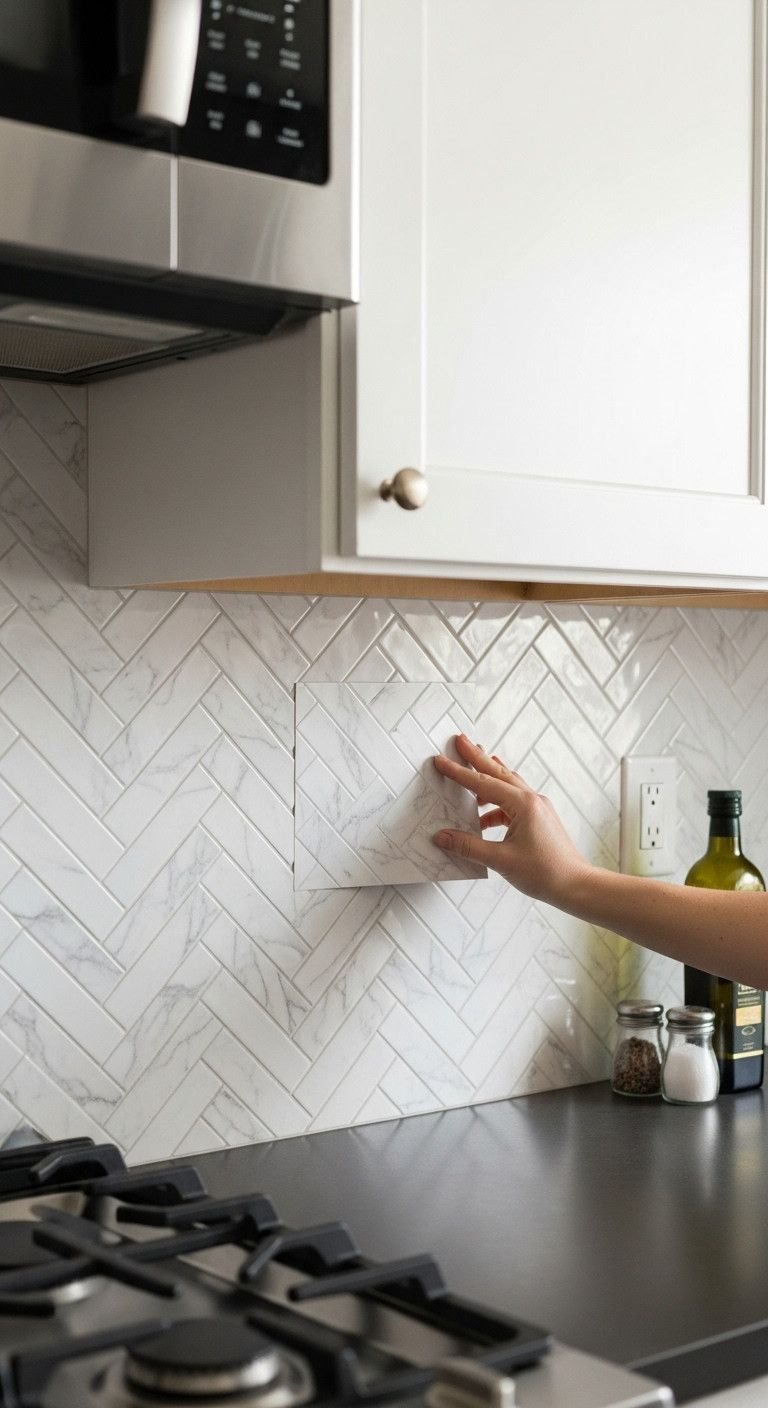
Save this renter-friendly upgrade idea for later!
A boring or dated backsplash can make your whole kitchen feel drab. A peel and stick backsplash is a perfect renter friendly kitchen idea to add a major dose of style without any permanent changes. These easy-to-install, temporary tiles are a fantastic budget friendly kitchen idea that can completely transform the look of your space in an afternoon.
Materials Needed:
- High-quality peel-and-stick tile sheets (measure your wall space to buy enough, plus 10% extra for mistakes).
- Degreasing cleaner (like TSP or simple green).
- Lint-free cloths.
- Tape measure and pencil.
- A straight edge or level.
- A sharp utility knife.
Step-by-Step Directions:
- Prep the Wall: This is the most important step. Thoroughly clean the wall with a degreasing cleaner to remove any grease or grime. Let it dry completely for at least 24 hours.
- Plan Your Layout: Lay out the tile sheets on the floor to visualize the pattern. Start your installation in the most visible corner.
- Draw a Guideline: Use your level to draw a faint, perfectly straight line on the wall to guide your first row of tiles.
- Peel and Stick: Carefully peel back a few inches of the backing from your first tile sheet. Align it with your guideline and press it firmly onto the wall.
- Smooth and Continue: Slowly peel off the rest of the backing while smoothing the tile from the center out to remove any air bubbles. Overlap the tiles according to the manufacturer’s instructions to create a seamless look.
- Cut to Fit: For edges and outlets, measure the space, mark the back of a tile sheet, and carefully cut it to size with a utility knife and a straight edge.
Pro-Tip: For an ultra-realistic look, some brands recommend applying a thin layer of clear caulk along the bottom edge where the backsplash meets the counter.
5. Banish Shadows with Under-Cabinet Lighting
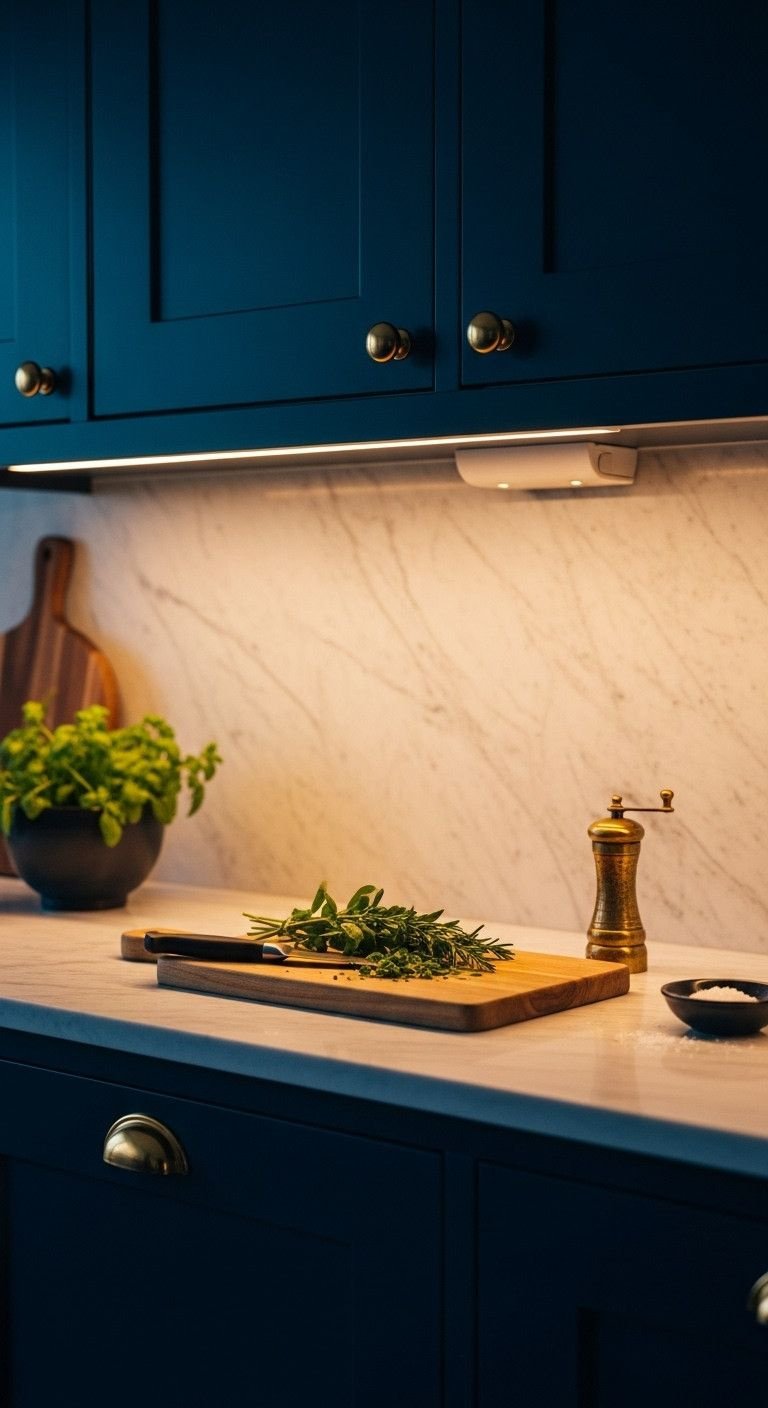
Save this bright idea to make your kitchen feel bigger!
Poor lighting is a common issue in small kitchens, making them feel dark, cramped, and unsafe for prep work. Installing under cabinet lighting is an easy-to-install solution that provides essential kitchen task lighting right where you need it. This simple upgrade not only banishes dark shadows on your countertops but also adds a warm, ambient glow that can make a small kitchen look bigger and more inviting.
Materials Needed:
- A plug-in or battery-operated LED under-cabinet light kit.
- Measuring tape.
- Rubbing alcohol and a cloth.
- Small clips or zip ties for cable management (for plug-in models).
Step-by-Step Directions:
- Choose Your Light Type: Decide between a plug-in model for continuous power or a battery-operated (or rechargeable) puck light model for the absolute easiest, no-wire installation.
- Measure and Plan: Measure the length of your cabinets to ensure you buy a kit that is long enough. Plan where the light strips will go and, for plug-in models, how the cord will run to the nearest outlet.
- Clean the Surface: Thoroughly wipe the underside of your cabinets with rubbing alcohol to ensure the adhesive backing on the light strips will stick properly. Let it dry completely.
- Install the Lights: Peel the backing off the LED strip or puck light and press it firmly into place under the cabinet. It’s best to place them towards the front of the cabinet to illuminate the counter evenly.
- Manage Cords: If using a plug-in model, use small adhesive clips to neatly run the power cord along the back corner of your cabinets to the outlet, making it virtually invisible.
Lesson Learned: Choose lights with a “warm white” color temperature (around 3000K) for a cozy, inviting glow rather than a harsh, blue-toned “cool white.”
6. Tame Drawer Chaos with Adjustable Organizers
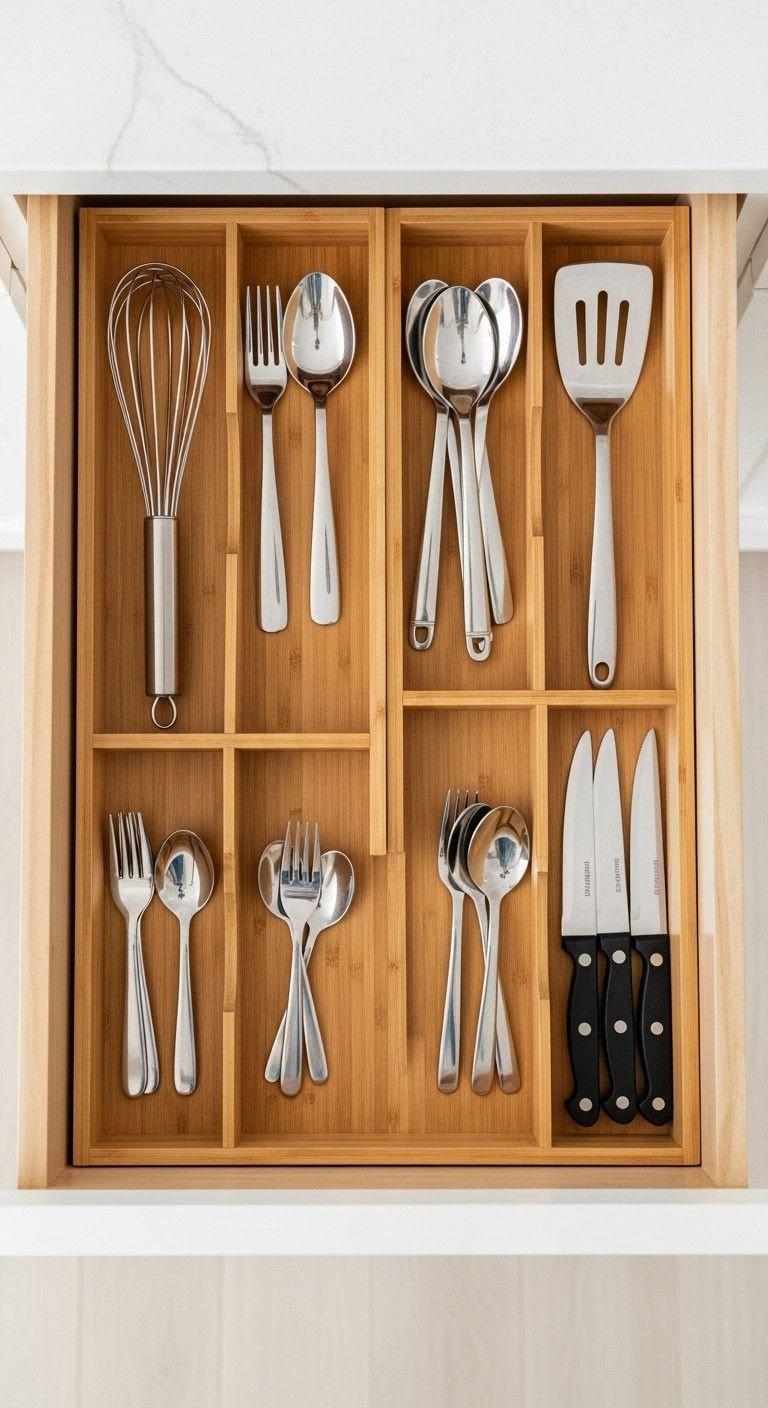
Pin this satisfying organization hack!
The cluttered kitchen problem often starts in the drawers. When utensils are just thrown in together, finding what you need becomes a frustrating search. An expandable kitchen drawer organizer with adjustable drawer dividers is the perfect way to declutter and bring order to the chaos. These simple inserts allow you to create custom-sized compartments for everything, making your utensils organized and instantly accessible.
Materials Needed:
- Adjustable/expandable drawer dividers (bamboo and plastic are popular choices).
- Measuring tape.
- Non-slip drawer liner (optional but recommended).
Step-by-Step Directions:
- Empty and Clean: Take everything out of the drawer. Wipe it down to remove any crumbs or dust. This is also a great time to get rid of any utensils you never use.
- Measure the Interior: Measure the inside length, width, and depth of your drawer.
- Insert Dividers: Purchase dividers that fit your drawer’s dimensions. Spring-loaded bamboo dividers are great because they press firmly against the sides of the drawer and stay in place.
- Create Custom Zones: Adjust the dividers to create compartments perfectly sized for your items. Group like with like: all forks together, all cooking spoons together, etc.
- Reload Neatly: Place your items back into their new, designated compartments.
Pro-Tip: For deep drawers where you store food storage containers, use deep drawer dividers to separate the containers from the lids. You’ll never lose a matching lid again.
7. Utilize Awkward Gaps with a Slim Rolling Pantry
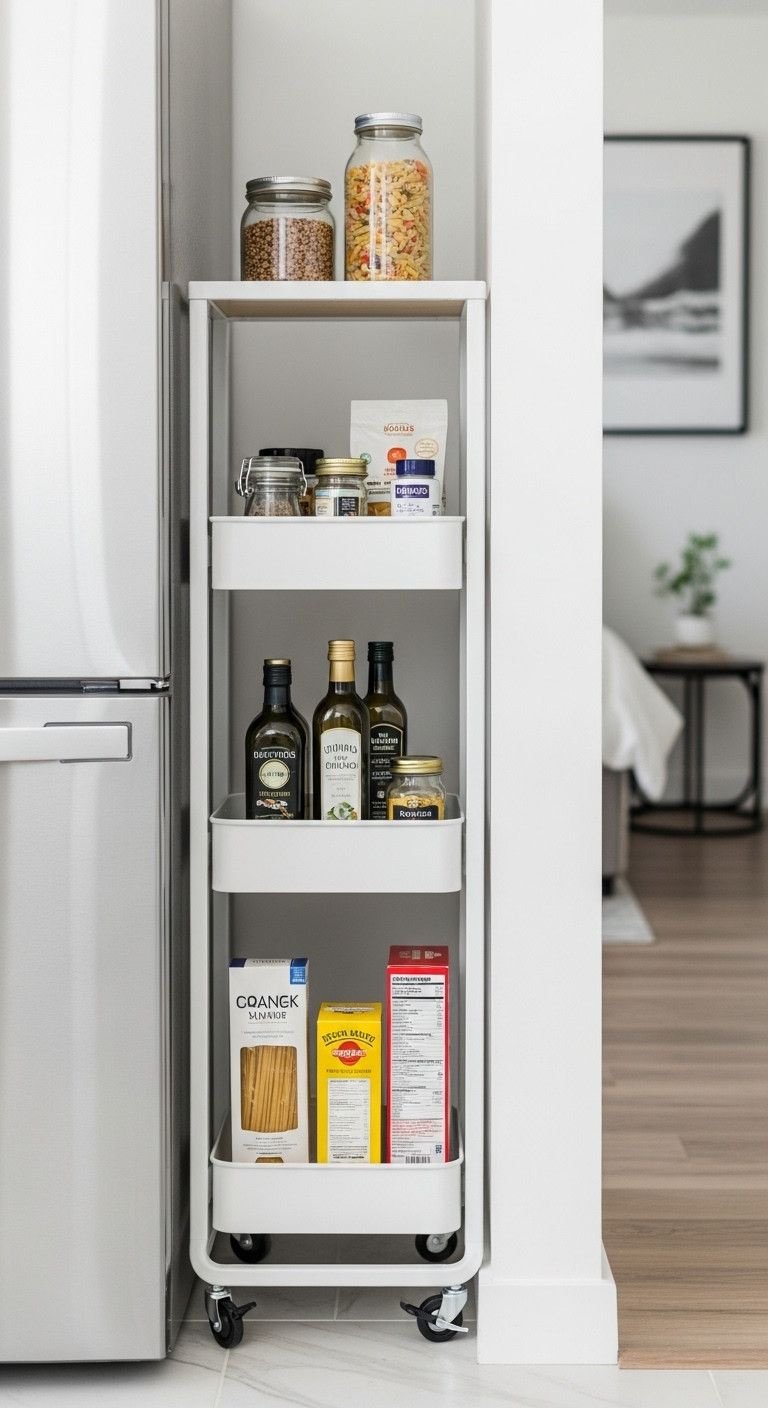
Save this genius idea for tiny spaces!
That awkward gap next to your refrigerator is a common feature in many apartments—and it’s usually just a magnet for dust. A slim pantry storage cart is a brilliant solution that transforms this wasted space into a functional, rolling pantry. It’s the perfect fix for a lack of pantry space, providing accessible, organized storage for spices, oils, canned goods, and other dry goods.
Materials Needed:
- A slim rolling storage cart or shelving unit.
- Tape measure.
Step-by-Step Directions:
- Measure the Gap: Carefully measure the width, depth, and height of the gap you want to fill. These carts come in various sizes, so precision is key.
- Purchase the Right Cart: Find a slim rolling cart that is slightly narrower than your gap to ensure it can slide in and out easily.
- Assemble and Fill: Assemble the cart according to the instructions. Organize your pantry items on the shelves, placing heavier items on the bottom for stability.
- Slide Into Place: Simply slide the fully stocked cart into the gap. It disappears when not in use and rolls out easily when you need to grab spices, oils, or canned goods.
Lesson Learned: This is the perfect solution for renters because it requires no installation, adds a huge amount of storage, and you can take it with you when you move.
8. Double Your Cabinet Space with Door-Mounted Racks
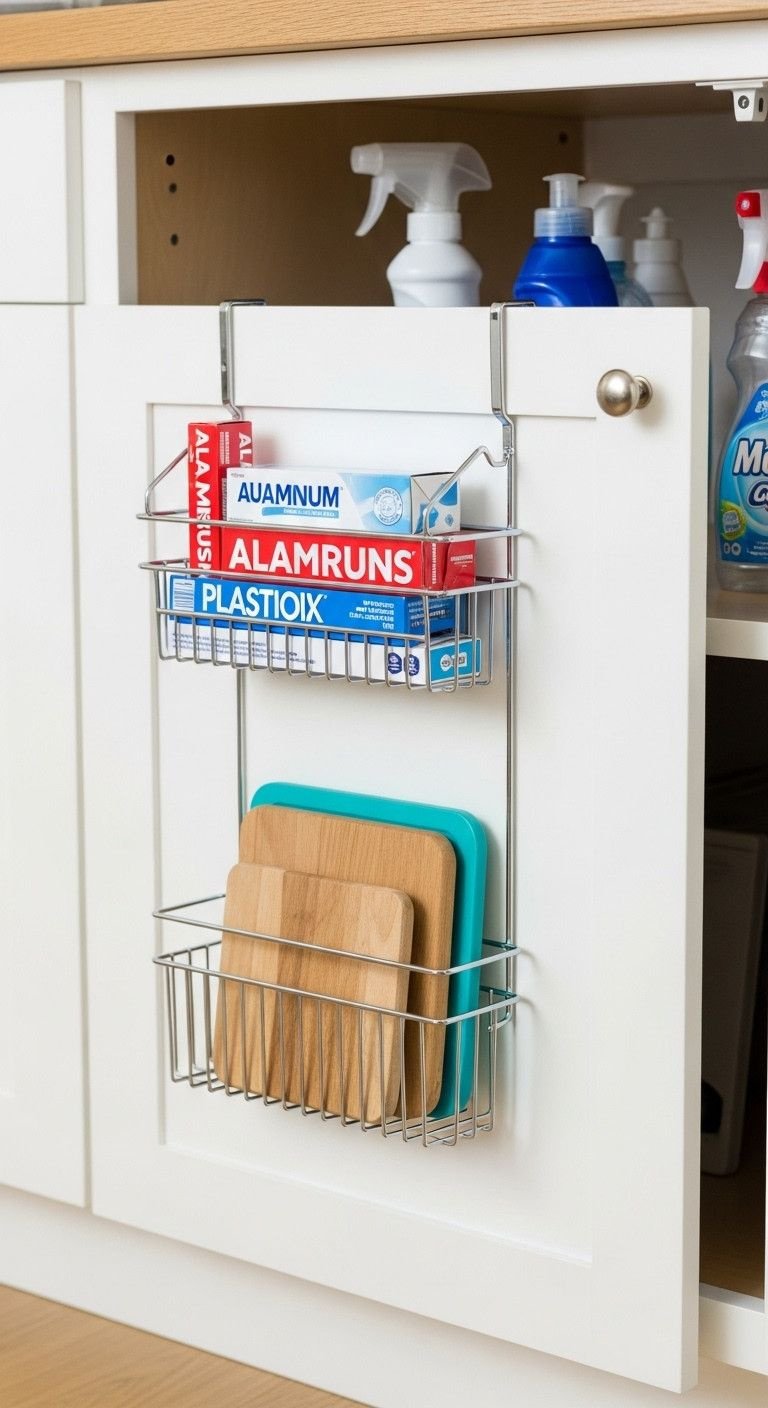
Don’t forget this easy storage hack—pin it!
The inside of your cabinet doors is some of the most underutilized real estate in your kitchen. An over the cabinet door organizer is a simple, renter friendly way to solve your limited kitchen storage problems. These handy racks require no tools to install and can be used to organize everything from spice jars and cutting boards to cleaning supplies and aluminum foil, freeing up valuable shelf space inside your cabinets.
Materials Needed:
- Over-the-cabinet-door organizers (choose a style that fits your needs: spice rack, cutting board holder, or general basket).
- Measuring tape.
Step-by-Step Directions:
- Measure Your Door: Measure the interior width and height of your cabinet door.
- Check for Clearance: Before you buy, open and close the cabinet door to make sure there’s enough clearance between the door and the shelves inside for a rack to fit.
- Choose Your Organizer: Select a rack designed for what you want to store. A shallow spice rack is perfect for an upper cabinet, while a deeper basket for cleaning supplies or cutting boards works well under the sink.
- Hang and Organize: Most of these organizers simply hook over the top of the cabinet door with no tools required. Hang the rack and fill it up to instantly free up shelf space.
Pro-Tip: To prevent the rack from rattling or scratching the door, add small, clear adhesive rubber bumpers (cabinet door stops) to the back of the rack where it touches the door.
9. Create a Dining Nook with a Wall-Mounted Drop-Leaf Table
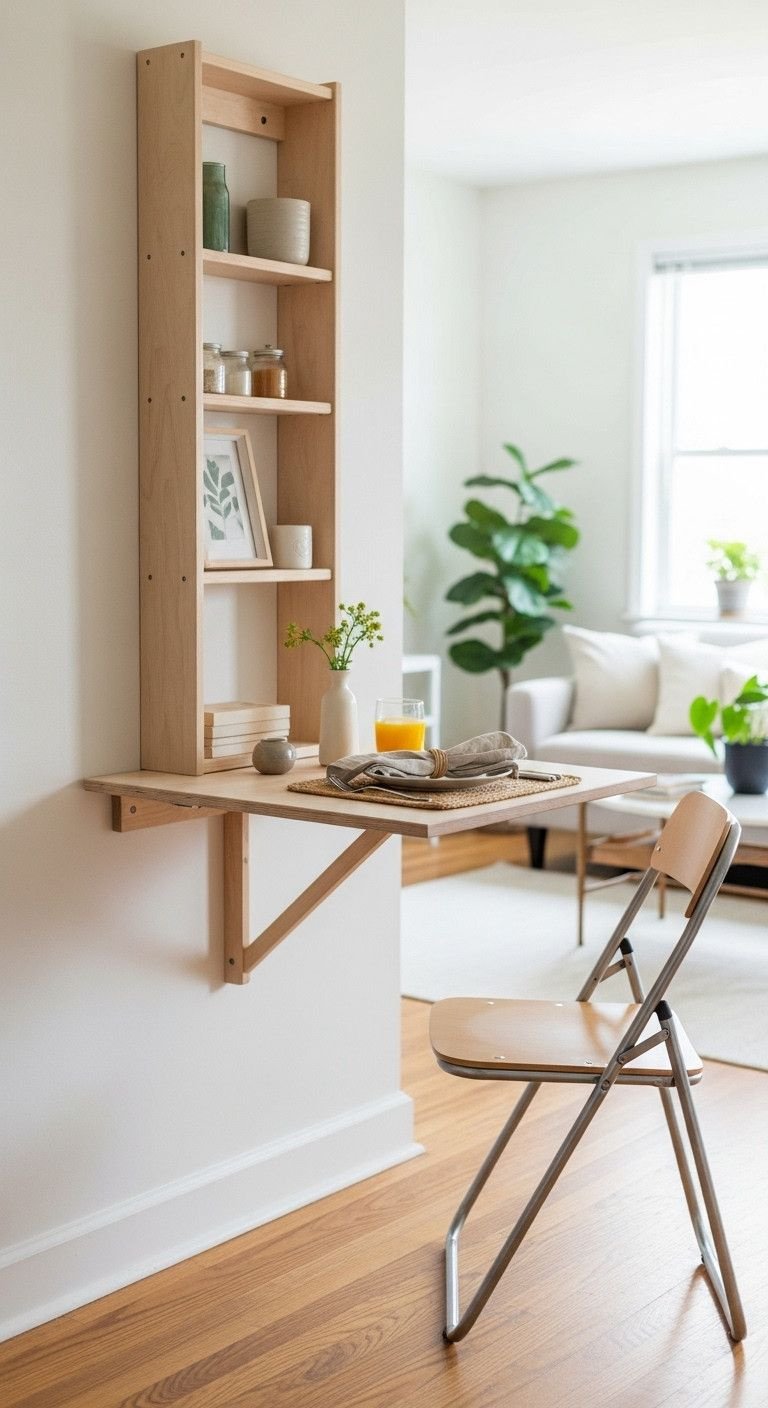
Save this space-saving dining solution!
Having a proper dining table in a studio apartment can feel like an impossible luxury. A wall mounted drop leaf table is the perfect piece of multi functional furniture for small space living. This foldable dining table mounts to the wall and folds down flat when not in use, conserving precious floor space. When you’re ready to eat or work, simply lift the leaf to create a sturdy surface, instantly creating a dining nook.
Materials Needed:
- A wall-mounted drop-leaf table kit.
- Stud finder.
- Power drill.
- Level.
- A friend to help hold it during installation.
- Stylish folding chairs that can be hung on the wall when not in use.
Step-by-Step Directions:
- Find the Right Spot: Choose a section of an empty wall that is convenient to the kitchen but doesn’t block a major walkway.
- Locate Studs: A wall-mounted table must be anchored into wall studs to be secure. Use a stud finder to locate them and mark their positions.
- Mark and Level: With a friend’s help, hold the table’s mounting bracket against the wall. Decide on the height (standard table height is 30 inches) and use a level to ensure it’s perfectly straight. Mark the screw holes.
- Drill and Mount: Drill pilot holes into the studs on your marks, then securely screw the table’s mounting bracket to the wall.
- Test the Mechanism: Lift and lower the tabletop a few times to ensure the folding mechanism works smoothly and locks securely into place.
- Add Seating: Pair the table with slim folding chairs that you can easily store or hang on decorative wall hooks nearby.
Pro-Tip: Mount a small, floating shelf above the table to act as a display for a plant or art, which helps define the area as a distinct ‘dining nook’.
Key Takeaways: Your Quick Guide to a Better Studio Kitchen
- Go Vertical: The most valuable real estate in a small kitchen is the wall space. Use it for pot racks, knife strips, and shelving to free up counters.
- Embrace Mobility: A rolling cart is your best friend. It acts as a flexible island, extra storage, and a mobile prep station that can be moved out of the way.
- Renter-Friendly Upgrades Rock: Don’t underestimate the power of non-permanent changes. A peel-and-stick backsplash and over-the-door organizers can transform a space without any damage.
- Light It Up: Good lighting, especially under-cabinet task lighting, is crucial. It makes the space safer, more functional, and feel significantly larger.
- Think Multi-Function: Every item should work hard. Choose a drop-leaf table that’s also a desk or a cart that’s also a coffee bar.
People Also Ask About Small Studio Apartment Kitchens
How can I get more counter space in a studio kitchen?
The fastest way to get more counter space is by adding a rolling kitchen cart. This provides a mobile island for prep work. Additionally, clear your existing counters by using vertical storage like wall-mounted pot racks, magnetic knife strips, and an over-the-sink dish rack to get bulky items out of the way.
How do you make a studio kitchen look good?
To make a studio kitchen look good, focus on decluttering, cohesive style, and good lighting. Keep countertops as clear as possible. Use renter-friendly upgrades like a stylish peel-and-stick backsplash. Finally, install under-cabinet lighting to make the space feel bright, open, and more luxurious.
What is the best layout for a tiny kitchen?
A ‘one-wall’ kitchen layout is typically the most space-efficient for a studio apartment. This design places all appliances, cabinets, and countertops along a single wall, which maintains an open feel and maximizes floor space. For narrow nooks, a ‘galley’ layout can also work if you have at least 42 inches of clearance between the two sides.
How do I add a pantry when I don’t have one?
Create a “pantry” by using a tall, narrow shelving unit or a freestanding cabinet on an empty wall. Another brilliant solution is a slim, rolling pantry cart designed to fit in the awkward gap next to your refrigerator, turning wasted space into valuable storage for spices and dry goods.
Final Thoughts
A small kitchen doesn’t have to be a frustrating one. By shifting your perspective and using a few clever, space-saving ideas, you can transform a cramped and cluttered corner into a space that is not only highly functional but also a stylish and enjoyable part of your home. You don’t need a massive renovation; you just need smarter solutions.
Start with the one idea from this list that solves your biggest problem. You’ll be amazed at the difference it can make in your daily routine and your love for your home.
What’s the #1 challenge you face in your studio kitchen? Share in the comments below
Last update on 2025-10-31 at 23:57 / Affiliate links / Images from Amazon Product Advertising API
